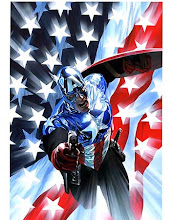Rules of the Marvel Universe
For as long as I've been reading Marvel Comics there's been some story and illustration rules that made Marvel stories feel Marvely. Some of these rules have remained constant and others have been tossed aside for the sake of a good story. "Bucky Stays Dead". Did anybody ever really believe that the several Buckybots and clones sent by the Red Skull to torment Cap were going turn out to be Bucky miraculously back from the dead? No. He was blown up. Nobody walks away from that, right? A good example is Tales of Suspense 88, where a Bucky is seen on a monitor saying to Cap, "Cap! Cap! It's me Bucky! I'm Alive! I've been held prisoner all these years!" When I first heard that somebody, I didn't yet know who Ed Brubaker was, had the gall to resurrect a character traditionally seen in WWII flashbacks and retro-continuity stories like The Invaders I thought it was going to bomb. It sounded like yet another "event" from the House of Old Ideas. Against the odds Brubaker has seamlessly reintroduced Bucky, aka The Winter Soldier, as a vital and interesting character. It helps that he hasn't been over used. Outside of Captain America he's appeared in The Winter Soldier one-shot during Civil War and an obligatory appearance in Wolverine Origins, where it turns out he killed Wolverine's wife or girlfriend- it seemed a little much that in his previously unknown past he knew both Black Widow and Wolverine. Did everybody know Wolverine in the past?
There are far more people on the Marvel Earth than in reality. This becomes clear by several points: For every supervillain there's at least a few henchmen. Some street level guys may rarely have henchmen but they all seem to know where they can find highly trained ex-military personnel to make up their private entourage. More financed megalomaniacs like the Red Skull have employed thousands of dedicated and uniformly costumed soldiers ready to ineptly carry out their employers wishes. Then there's HYDRA and AIM and SHIELD, all of which employ apparently tens of thousands of military, science, and intelligence personnel. These groups need factories of people to produce their respective matching attire, exotic weaponry, and more people to service their housing and food needs. More people are needed to build their secret lairs and complicated underground fortresses and doomsdays devices, etc. There is not this many readied, available and easily expendable ex-military personnel in all of the real world.
Secondly, there must be more people in the Marvel Universe to compensate for all those who die at the hands of supervillain plots, urban monster disasters, cosmic accidents that rent the fabric of space and time (if these affect the X-men, for instance then Joe and Jane Schmoe must also occasionally lose their memories or vanish from existence,) and keep society from falling apart, rebuild communities (Damage Control). There are dozens of more countries and civilizations, Latveria and Atlantis for example, and resources remain apparently stable despite the hundreds of millions more people needed to populate these regions (which might also mean the Marvel Earth is physically bigger.)
Time progresses in a fictional way in the Marvel Universe.
The good folk at the Marvel Chronology Project- www.chronologyproject.com
have been attempting to put into chronological order all of the appearances of each and every Marvel character. This is brilliant in the way that TV show and comic blogs, like mine, are not. It is a useful tool for a story world that is nearly fifty years old and unwieldy. Another project is an attempt to calendar the events in the comics into conventional times, utilizing portrayals of day and night, the moon, holidays, etc. I think this is cool but flawed. The Marvel Universe is a fictional world where chronology is possible although imperfect but relating that to 365 day years is counter intuitive. Here's a different approach to reconciling topical mentions of real years (like if a character in an old comic says something like "1976 is going to be the best year ever" but its clear that he's been written to age only a few years since then) with obvious time lag- time moves fictionally, it's just a comic book. Characters like Cap kept in suspended animation, or time traveled like Cable or Bishop, may actually be aging, even progressing through time differently than the average person. So many stories have involved the radical altering of space and time that its perfectly understandable that characters who lived in the early seventies would still look little unaged, they age normally while time moves fictionally around them. Another option is for writers and artists to stop making and using precise dates. "Several years ago..." could mean five years or fifteen years back.
I applaud the Marvel Calendar idea but I think its too rooted in reality for a comic book clock.



